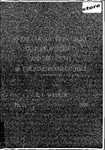In the Labyrinths of Deceit: Culture, Modernity and Disidentity in the Nineteenth Century
| dc.contributor.supervisor | Dr Lopez, Tony | |
| dc.contributor.author | Walker, Richard Joseph | |
| dc.contributor.other | Faculty of Arts, Humanities and Business | en_US |
| dc.date.accessioned | 2012-08-17T11:07:22Z | |
| dc.date.available | 2012-08-17T11:07:22Z | |
| dc.date.issued | 1999 | |
| dc.identifier | Not available | en_US |
| dc.identifier.uri | http://hdl.handle.net/10026.1/1149 | |
| dc.description.abstract |
This thesis examines the nature of identity and the problems implicit in attempts to affirm it within the context of nineteenth century modernity. By exploring a number of texts from Romanticism to the fin de siecle, it can be. seen that autonomous and coherent identity is not a stable entity. Drawing upon Rene Descartes'work on constructions of selfhood as a starting point, these ideas can be detected in an assessment of identity's alter ego - the disidentical self which is characterised by masks, disguises, madness, pathological behaviour, criminality and addiction. Examples of such paradigms for disidentity can be found in a variety of cultural texts and genres throughout the century, from the self-consciously 'high' poetry of Matthew Arnold, Alfred Tennyson and Gerard Manley Hopkins to the popular Gothic novels of Robert Louis Stevenson, Oscar Wilde and Bram Stoker. These metaphorisations of a crisis for identity in the nineteenth century are reflected in the analyses of insanity by physicians such as W.A.F. Browne and Henry Maudsley, prominent cultural critics such as Arthur Hallam and Amold, and the degeneration theorists of the late nineteenth century. Much of the project is shaped by Karl Marx and Friedrich Engels' assessment of modernity found in The Communist Manifesto, in particular their descriptions of nineteenth century socio-cultural topographies as fluid and vaporous. Stable identity is effectively threatened from a plethora of directions, including the Orient, criminality, sexual deviancy, scientific discovery and accelerated social change. Taking into consideration the many different ways in which identity can be problematised in the nineteenth century, three important sites of disidentification have been chosen for the purposes of this argument. Chapter one examines the split-personality, chapter two religious madness, and chapter three addiction. Each chapter demonstrates that within the conditions of nineteenth century modernity, the fragility and consequent fragmentation of individual identity is evoked in many different manifestations. | en_US |
| dc.language.iso | en | en_US |
| dc.publisher | University of Plymouth | en_US |
| dc.title | In the Labyrinths of Deceit: Culture, Modernity and Disidentity in the Nineteenth Century | en_US |
| dc.type | Thesis | |
| plymouth.version | Full version | en_US |
| dc.identifier.doi | http://dx.doi.org/10.24382/4526 |
Files in this item
This item appears in the following Collection(s)
-
01 Research Theses Main Collection
Research Theses Main


